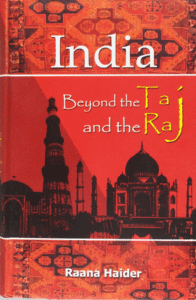Travels in Time
By Vaqar Ahmed | Bookmark | Published 6 years ago

There are travel books and there are history books. Travel books are usually a traveller’s firsthand experience of journeys with some references from history books as background, while history books rigorously refer to published works and other documented sources. The book under review falls somewhere between these two categories. In the author’s own words, “A literary travelogue, India: Beyond the Taj and the Raj is underlined with the work of several generations of scholars who accompany me on a journey – on many planes – through the vast, diverse and complex tapestry that is India.”
The book is an account of the travels and observations of the author, the daughter of a Pakistani diplomat. The book starts with her time spent in Delhi in the mid-1950s and ends full circle back in Delhi in 2002-2003. The journey in the book takes the reader from Delhi to Pondicherry, describing all the important stopovers like Lucknow, Srinagar, Calcutta, Bombay, Hyderabad and Madras, and some destinations off the beaten track like Somnathpur and Mamallapuram. The book was researched and written from 2004-2009 and first published in 2013.
It is a mix of personal observation, stories of encounters with well known literary figures like Ruskin Bond and Khushwant Singh, autobiographical accounts, and material from other published works. The content leans heavily towards using the observations of other historians. This approach would have been fine if the book was an academic work on the history of these locales. If that were the case then the anecdotal observations and personal history would not be relevant and the discipline in the formal methods of referencing for material would have been used. For example, the first 14 paragraphs in the chapter on Aligarh that recount a road journey taken to the city, consist of just three paragraphs that are personal observations, and the rest is material taken from published works by others. It would have been more meaningful and interesting if it were the other way around as the book is supposed to be a literary travelogue and not a book on history.
In terms of structure, a chapter begins with a personal account of the start of a trip undertaken to a city, followed by a longer descriptive part from references. Later, a few more personal accounts appear that are again followed by referenced material. This approach makes the flow of the book very predictable.
One issue with the book is that the personal observations have become dated due to the large delay between the observations and the time of publication. The author’s personal observations are from the 1950s to 2003, but the book was published in 2013. For a travelogue, that dates it. For example, this description of the Mehrauli area of Delhi, “Today…Mehrauli once home to centuries of human habitation, is now home to decay, desertion and death-tombs and mausoleums scatter the site.” It is not clear from the book if this observation is from 2002 or from some time later, as it is preceded by today. Without a clear reference to the time of an observation, its relevance diminishes.
Overall, the book is a mixed bag. On the positive side, it provides a good picture of almost all of India that goes beyond the traditional tourist stops and topics like the Taj and the Raj. On the negative side, it relies too heavily on the observations of others (mostly western sources), and ends up being a limited personal memoir, albeit of an intelligent and well-read observer who has an interest in the history of the places she visited. Finally, the book would have benefited from more thorough editing to improve the overall flow, punctuation and spelling.
The writer is an engineer by training and a social scientist by inclination.


